One was at Fairlands Valley Lakes on 17 June 2022.
[ thought or known species of introduced or captive origin ]
One was at Fairlands Valley Lakes on 17 June 2022.
[ thought or known species of introduced or captive origin ]
Very rare visitor
Two records from Fairlands Valley Lakes, a pair seen on 21 February 2021 and a drake on 22 December 2023.
Irregular visitor and, breeding resident.
Mostly seen at Fairlands Valley Lakes and the Town Centre Gardens. With additional records of two flying over Woodland Way on 10 April 1967, two flying over the Old Town on 12 September 1973, six flying over Stevenage on 25 September 1975, four flying over Watery Grove on 29 July 1981 and, a ringed bird (889) at Glaxo Smith Kline on 26 September 2016.
They were first seen at Fairlands Valley Lakes in 1973, the following is an account of these Swans from the Stevenage & District Ornithological Society’s Report for that year:
“Fairlands Lakes attracted four adults and one juvenile on 16 January (12 flying along the valley on 24 January did not stop and may have been Mutes) but after a young bird was found shot apart from one on 11 February it wasn’t until 16 September that two were seen to stay, then five from 4 October and finally five or six regular until the end of the year.”
In 1974 they were seen all year at Fairlands Valley Lakes except for in June and August, with six seen on 4 March. A young bird appeared to be resident in 1975.
A pair attempted to breed at Fairlands Valley Lakes in 1976. Breeding was successful in 1977 with two cygnets seen during May one of which was subsequently killed by a Dog, whilst the other died by swallowing a fishing line. Two were also seen to mate on 8 January 2001, but did not stay to breed.
In 2016 a ringed pair (male 4COO and female 48NN) nested on the Millennium Lake Island but failed to breed. (The male was originally red colour ringed with number 4AXO at London Colney as a cygnet on 10 September 2013 and, was first recorded at Fairlands Valley Lakes in March 2014. Having lost its original ring, it was replaced on 9 March 2017 with ring number 4COO. The female was ringed at Fairlands Valley Lakes on 9 March 2015 with red colour ring 48NN). In 2017 the same pair nested in the same place and produced six cygnets, which were first seen on 24 May. Unfortunately, between the 21 and, 26 July the number of cygnets was reduced to two. One is believed to have been taken into care by the R.S.P.C.A., the disappearance of the other three is unaccounted for. The two adults and, surviving two cygnets were seen until 14 September, when one of the surviving cygnets again mysteriously disappeared. The surviving cygnet and two adults were still at the Lakes until 5 October with the surviving cygnet last seen on 12 October.
The same pair nested again in 2018 and 2019 with seven cygnets seen on 27 May 2018, sadly the number of cygnets was reduced to one by 4 July and, the remaining cygnet was last seen on 12 September. Two cygnets were seen on 26th May 2019 but, were reduced to one by 4 July and, last seen on 26 July. Nesting was attempted again in 2020 with nest building seen on 19 February but, unfortunately the female (4BNN) was believed to have been killed by a Fox (Vulpes vulpes).
On 9 January 2022 the male (4COO) was seen with what appeared another female (ringed 4EJZ) together with another pair, an un-ringed, male and a female (ringed 4ETH). The female (4ETH) had been ringed as a five-year-old bird at Walthamstow Wetlands on 6 October 2020 and had subsequently been seen at Victoria Park, Hackney, Wanstead Flats and Nazeing Mead, Essex.
4COO and 4EJZ nested in 2022 with five cygnets seen on 23 May. Unfortunately, the cygnets were quickly reduced to one, with the surviving cygnet seen until 27 October. The same pair nested again in 2023 raising one cygnet, which was seen until 10 February 2024. Despite egg laying in 2024 and 2025 the pair were unsuccessful in producing any young.
There is a record of another ringed pair at Fairlands Valley Lakes in 2016, ring numbers, 4BIQ and, 4BOW unfortunately, 4BOW was found dead there at the end of the year having apparently hit some wires.
The most seen together are 11 at Fairlands Valley Lakes on 4 and 5 June 2000, and an unusual record is of a family group of two adults, and eight juveniles seen on 28 January 2008.
From 2014, when they were first seen with two cygnets on 17 November there was a regular wintering pair at the Town Centre Gardens. The female, ring number 888 was ringed as a cygnet at Digswell Lake near Welwyn Garden City on 16 March 2010 and, the male, ring number, 889 was ringed as a cygnet at Verulamium Lake, St Albans on 13 April 2002, they are regular breeders at Digswell Lake. The latest record of this pair at the Town Centre Gardens is 1 October 2020.
Four were present at the Town Centre Gardens throughout March 2025.
A 15, year old bird ringed at Verulamium, St Albans on 13 April 2000 (ring No. W00619) was seen at Stevenage on 17 December 2017 and, 11 November 2018.
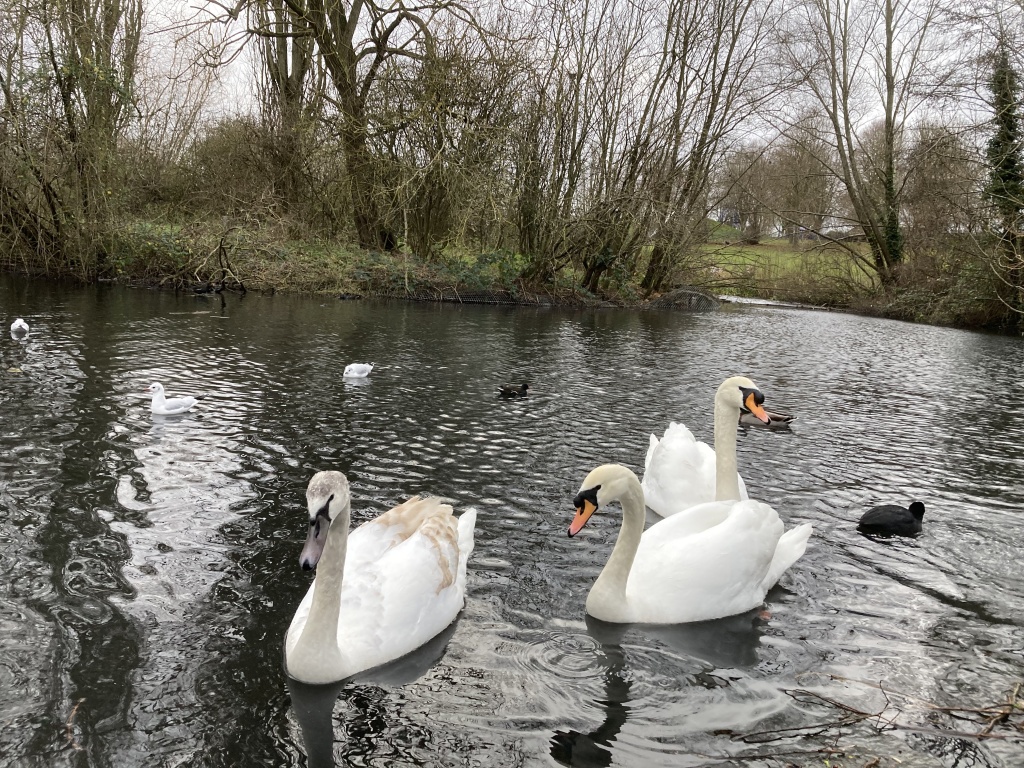
4COO and 4EJZ with cygnet Fairlands Valley Lakes 24 December 2023.
Single birds have been seen at Fairlands Valley Lakes on 29 and 30 October 2001, 17 to 23 June 2003, 29 November to 3 December 2015. Two seen from 21 July to 27 October 2016 and, one on 3 November.
[ thought or known species of introduced or captive origin ]
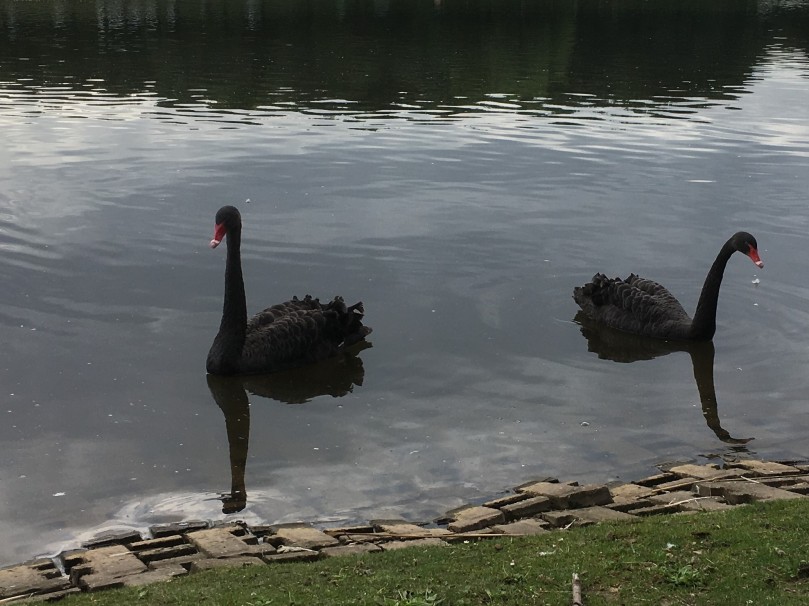
Very rare visitor.
25 Swans, possibly Bewicks flew over Fairlands Valley on 6 January 1985.
Very rare winter visitor.
Four records: two were recorded by the Stevenage Woodland Conservation Society as being at the Town Centre in February 1970, 30 recorded by the Stevenage and District Ornithological Society flying over Whomerley Wood on 6 March 1970, an adult and two first winter birds flying southwest over Astonbury Wood on 16 January 1991 and a juvenile at Fairlands Valley Lakes on 4 November 2022 (this bird was seen later the same day at Amwell and then at Rye Meads on 5 November where it remained until it died on 26 November).
Very rare visitor
One record: a juvenile at Fairlands Valley Lakes on 9 and 10 December 2010, during exceptionally cold weather.
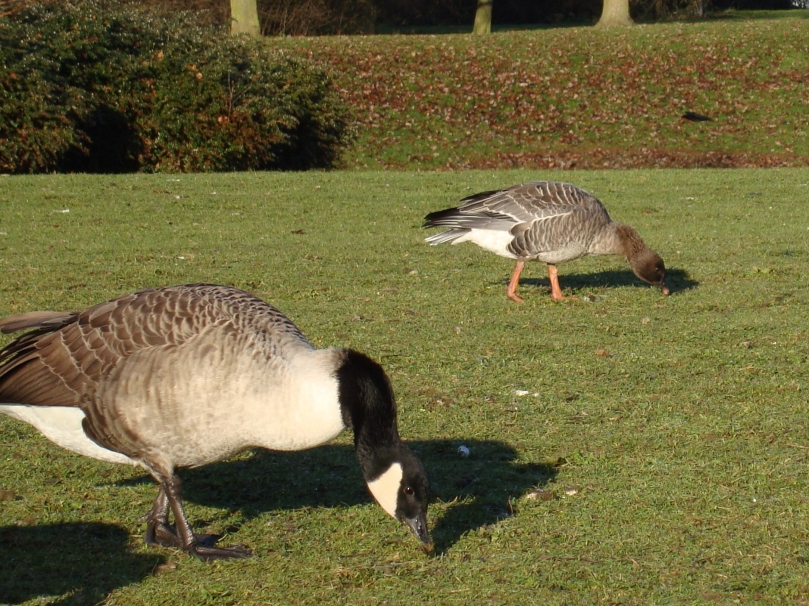
Very rare visitor
Two records: one at Fairlands Valley Lakes on 25 October 2013 and a first winter bird found at the Town Centre Gardens on 23 December 2020 and seen later that day at Fairlands Valley Lakes, having roosted overnight at the Lakes it flew off southeast on 24 December, the same bird was seen again briefly at Fairlands Valley Lakes on 13 and 15 February 2021.
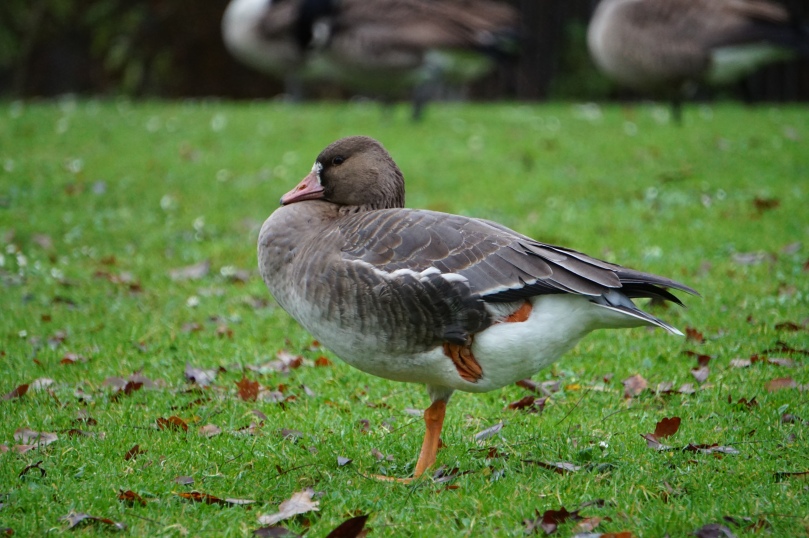
First Winter bird, Town Centre Gardens 23 December 2020
Increasing visitor and feral resident.
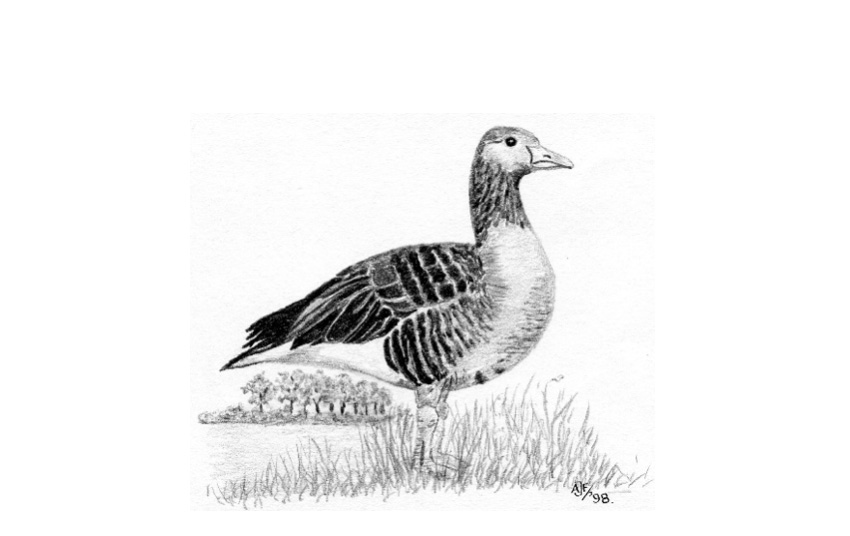
Domesticated Greylag Geese were formerly kept at farms in Stevenage for both food and their “guard dog” qualities.
In recent years the numbers of Greylag Geese of feral origin have increased in Hertfordshire with quite large flocks seen.
Birds of possible wild origin are occasionally seen at Fairlands Valley Lakes and birds of feral origin are regularly seen. The earliest record from there is from November 1983 and, the 33 seen on 12 November 2025 is the highest number of birds seen together there.
Single birds are also occasionally seen at the Town Centre Gardens, with five seen there on 5 July 2018.
Other records: four were seen flying over Norton Green Tip on 5 April 2016; two seen feeding among c.200 Canada Geese (Branta canadensis) at Astonbury Farm on 16 November 2022; two seen flying over Astonbury Wood on 31 March 2024; one flying over Astonbury Wood on 4 May 2024; five feeding among a flock of c.100 Canada Geese in a field behind Stringers Lane, Aston on 12 December 2025.
Breeding Resident.
Despite their familiarity they are only recent colonisers of Hertfordshire. In the 1950’s, this introduced species from North America, was a rare visitor to the County and did not breed until 1969. The earliest local record is 25 seen by the River Beane at Aston on 22 January 1940.
Now regularly seen at Stevenage with a large flock usually present at Fairlands Valley Lakes (where they were first recorded on 22 February 1972 when three were seen), and a smaller one at the pond in the Town Centre Gardens.
The most seen at Fairlands Valley Lakes are 830 on 24 October 2025. C.120 were seen at the Town Centre Gardens on 29 September 2016, 250 at Norton Green on 12 September 2017, c.200 at Astonbury Farm on 16 November 2022 and c.400 flying over Astonbury Wood on 5 October 2024 in groups of five and 20.
Regular as a breeding species at Fairlands Valley Lakes. During the 2018 breeding season 35 young and 12 nests were recorded. In 2019 11 pairs produced only one brood. 35 young from eight broods were recorded in 2021. They have also bred at Norton Green Pond in the late 1980s, and the pond at Astonbury Manor in 2006.
Large flocks are also often seen and heard flying over the town early in the morning and in the evening.
Birds have been seen at Fairlands Valley Lakes (10 October 1997, 3 March 2004 and 7 November 2025) and the Town Centre Gardens (18 June 2003, 12 to 23 March and 28 April 2004).
[ thought or known species of introduced or captive origin ]
Five were seen at Fairlands Valley Lakes from 17 October 1978 to January 1979 (when two left) the remaining three departed during April 1979 and, a ringed bird was there between 5 and 10 March 1980.
[ thought or known species of introduced or captive origin ]
An occasional visitor
Although some Siberian Barnacle Geese winter regularly in southeast England, those seen in Hertfordshire are considered to be feral birds.
They have been seen mostly singularly at Fairlands Valley Lakes, and the Town Centre gardens. Two birds were seen at Fairlands Valley Lakes on 12 September 2018 and, the Town Centre Gardens on 19 September 2018 and, up to two birds were seen at Fairlands Valley Lakes from 24 October to 5 December 2022.
A long staying bird was seen at Fairlands Valley Lakes between 15 June and 28 September 1999.
One was also seen at Norton Green Tip on 12 September 2017.
The most recent record is of one at Fairlands Valley Lakes on 1 April 2025.
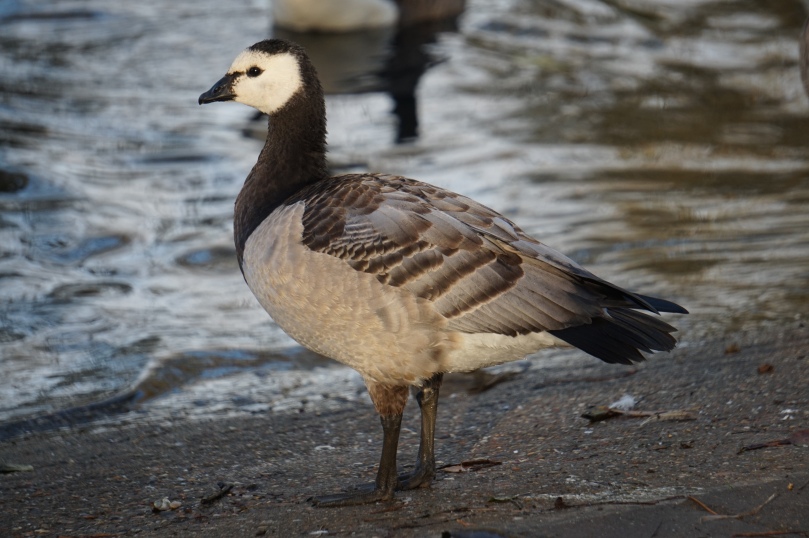
Fairlands Valley Lakes 4 November 2022
Very rare winter visitor and passage migrant.
An immature bird was at Fairlands Valley Lakes from 18 to 29 December 1994.
Two large flocks were seen flying over Stevenage in early 1996, the first, a flock of 28 flew high in a north westerly direction over the Old Town on 19 February, the other a flock of approximately 45 flew south west to east over Norton Green on 7 April.
One at Fairlands Valley Lakes on 15 January 2012.
One at Fairlands Valley Lakes from 12 to 20 March 2015 and, possibly the same bird at the Town Centre Gardens and Fairlands Valley Lakes on the, un-seasonable dates of 4 and 5 June 2015.
200 were seen flying low over the A1(M) near Stevenage in small flocks on 12 September 2024.
An increasingly regular visitor.
From a small feral population in Norfolk, this introduced species is now increasing and spreading in England.
The first record for Stevenage was of one at Fairlands Valley Lakes and the Town Centre Gardens between 24 January and, 6 February 2007. One was subsequently seen at Fairlands Valley Lakes and, the Town Centre Gardens between 10 and 12 October 2007.
They were not recorded again until 2011 when up to two were at Fairlands Valley Lakes between 25 and 29 July 2011.
Subsequent records prior to 2020 are; two on the GSK Site Lake on 21 December 2018; two at Fairlands Valley Lakes on 17 and 29 March 2019; two adults and four juveniles at Fairlands Valley Lakes on 17, 21 and 29 September and 6 October 2019 (assumed to be the birds that bred at The Park, Knebworth House that summer); eight at Fairlands Valley Lakes on 21 November 2019; three at Fairlands Valley Lakes from 24 to 1 December 2019; two at Fairlands Valley Lakes from 2 December 2019 until 12 January 2020, with 11 seen on 15 December.
The records for Fairlands Valley Lakes since 2020 are: four on 19 January 2020; one on 16 March 2020; up to nine between 23 and 27 July 2020; one on 28 October 2020; two adults and a juvenile seen between 26 September and 23 November 2021; seen in January, April, and August 2022 and up to seven on various dates from 28 September to 11 December; seen in January and May 2023 and up to nine between 14 July and 28 November 2023; between two and 10 seen on various dates between February and December 2024, 10 seen between 2 and 27 July 2024; three on 24 January 2025; one on 24 and 25 April and 11 May 2025; up to six between 10 and 25 June 2025; two on 8 and 17 July 2025; one between 28 July and 26 August 2025; up to five on various dates between 2 September and 14 October 2025; two on 14 December 2025.
Other records for Stevenage are: one flying over Norton Green Tip on 23 August 2022; one seen feeding among c.200 Canada Geese (Branta canadensis) at Astonbury Farm on 16 November 2022; two at Astonbury Farm on 29 October 2023.
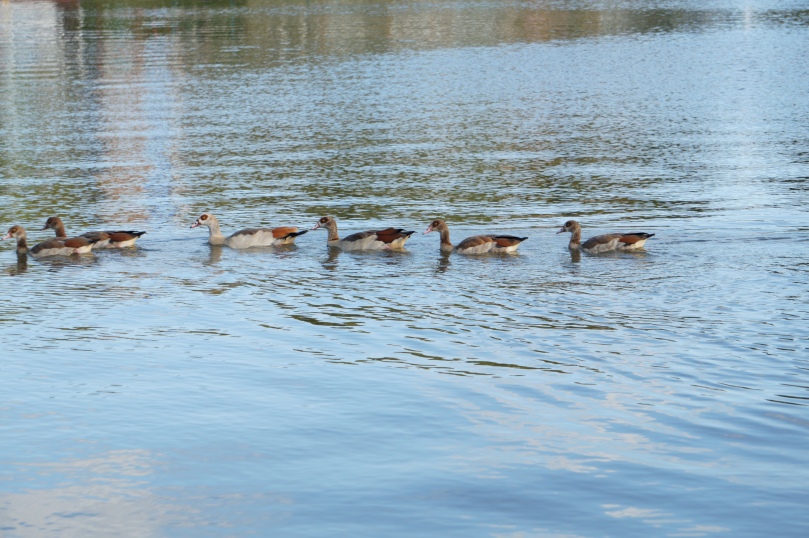
Very rare visitor.
Four records: one was seen at the Symonds Green water meadow in Gunnels Wood Road from January to March 1979, one at Fairlands Valley Lakes on 20 April 2013, one seen flying west over a Stevenage Garden on 30 November 2020 and two flying over Fairlands Valley Lakes on 12 April 2024
Formerly seen regularly at Fairlands Valley Lakes, and the Town Centre Gardens, until the late 1990’s, breeding at both sites.
[ thought or known species of introduced or captive origin ]
A male and two females were seen at Fairlands Valley Lakes on various dates in 1986 and 1987.
[ thought or known species of introduced or captive origin ]
Seen at Fairlands Valley Lakes on: 8 November 1986, 26 December 1986, 31 January 1987 (2 drakes and 3 females), 28 February 1987, and 17 March 1990 (a drake and female).
[ thought or known species of introduced or captive origin ]
An occasional visitor.
In the 1970s and 1980s Mandarin Ducks were occasional visitors to Fairlands Valley Lakes and the Town Centre Gardens, with the following records:
Fairlands Valley Lakes: Two Males 30 April 1974; an immature male 20 July 1974; one 28 April 1975; one female 1 March 1976; one male from 18 August until the end of September 1981; one female 23 February 1982, and a male and female 31 January and 28 February 1987.
Town Centre Gardens: A male described as, “scruffy and bedraggled” seen from 29 May until August 1981, which was seen again 8 November and 12 December, and one male seen throughout April 1982.
One was also reported as, “flying between waters” in December 1983 (Presumably between Fairlands Valley Lakes and the Town Centre Gardens.)
They were not recorded from Stevenage again until a male was seen at Fairlands Valley Lakes on 26 March 2008. They have since been recorded from:
Astonbury Manor: Pair seen on 28 March 2025; three drakes by the pond on 27 April 2025.
Astonbury Wood: A pair seen on 27 March and, 9 April 2020; a drake on 11 April 2020; two pairs on 22 April 2022; one drake on 11 April 2025; three drakes on 13 April 2025.
Fairlands Valley Lakes: A female from 7 to 17 December 2010, female on 27 March 2011, a drake on 12 April 2011, a drake from 31 September to 16 November 2017, a drake on 5 June 2018, two females from 12 to 14 August 2019, a female on 24 October 2019, a drake on 31 October 2019, an eclipse type on 1 June 2020, a drake on 25 September 2020, a female from 23 to 25 November 2021, a female on 20 October 2022 and a male on 8 April 2023.
Watery Grove: A pair seen from 3 to 8 April 2014; two seen on 2 April 2017; one seen on the pond opposite Norton Green Farm on 18 March 2023; two flying over on 19 March 2023; drake and female flying over on 20 March 2023.
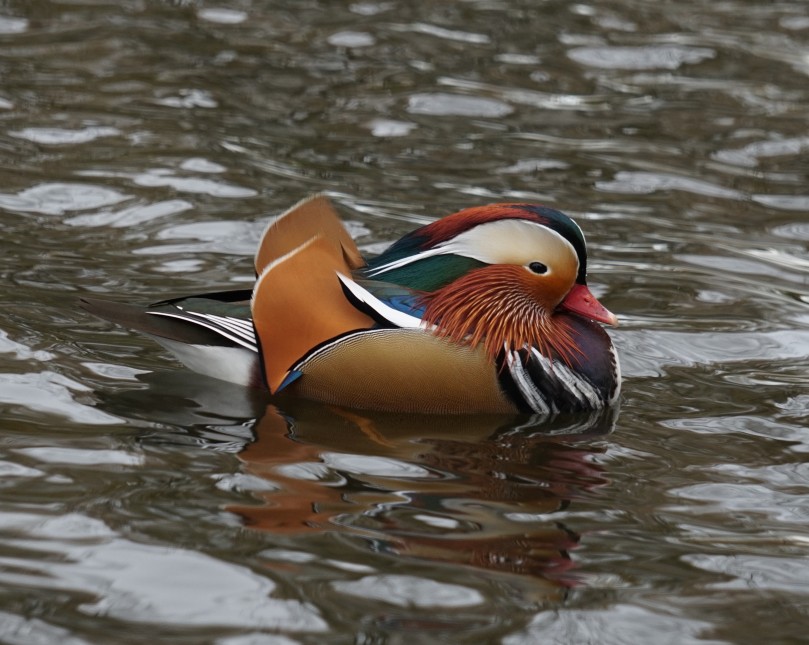
Occasional winter visitor and passage migrant.
Occasional visitors to Fairlands Valley Lakes between September and March, the first record was a drake seen between 19 and 25 March 1976. They were not recorded again until 26 February 1980 when a drake and three females were seen. There were two further records in the 1980s.
During the 1990s there were eight records. Between 2000 and 2009 six records and, between 2010 and 2019 ten records.
Since 2020 there have been 12 records: four 17 September 2020; two 17 September 2021; female 13 October 2021; drake and female 17 December 2021; two 15 October 2022; three 20 October 2022; one 1 November 2022; drake and female 1 December 2022; three 2 December 2022; drake 6 September 2023; female 22 September 2023; female 8 November 2024; drake and two females 13 October 2025, with the drake remaining until 23 October.
The most seen together are, nine on 17 January 2013.
Away from Fairlands Valley Lakes a drake was seen at the Town Centre Gardens during February 1987.
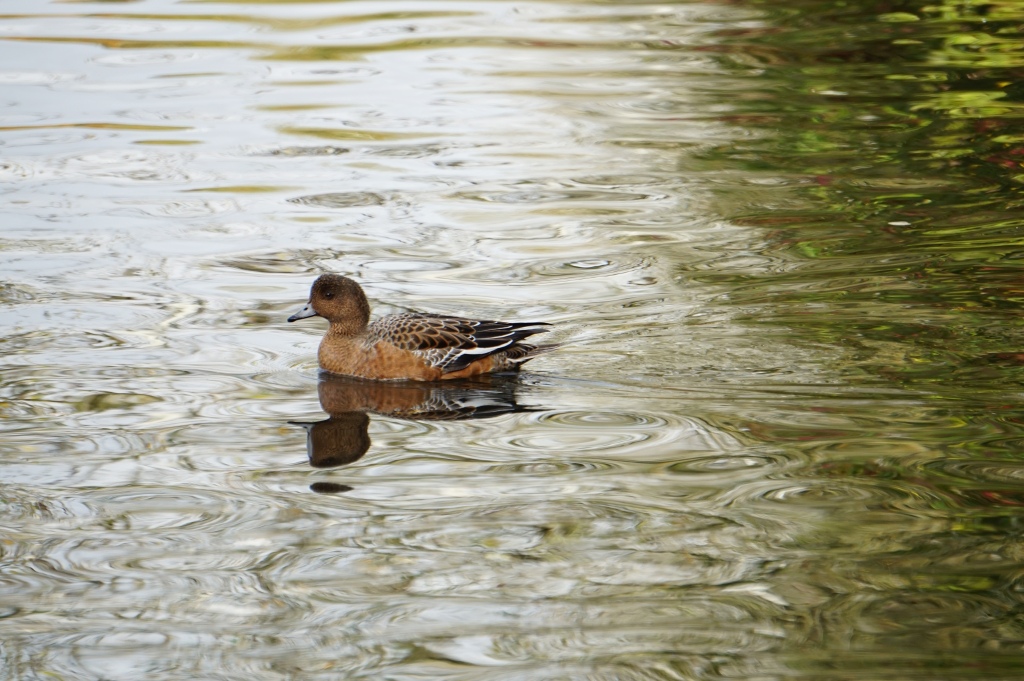
Two drakes and a duck were seen at Fairlands Valley Lakes in December 1975, and remained there during 1976, when they were also seen at the Town Centre Gardens.
[ thought or known species of introduced or captive origin ]
Occasional winter visitor and passage migrant.
Prior to 1850 when they were introduced into Norfolk, Gadwall were only visitors in small numbers to Britain. They were not recorded in Hertfordshire until 1925 and, were first recorded in North Hertfordshire in 1954 when a female was at Radwell Lake near Baldock during February and March.
Occasional visitors to Fairlands Valley Lakes between August and April (with the exception of one seen on 21 June 2024), from where they were first recorded on 1 November 1993, when a drake was seen. There were three further records in the 1990s.
Six records between 2000 and 2009 and a further six records between 2010 to 2019.
The most seen together are, five (three drakes, two females) on 20 October 1997.
Since 2020 there have been 21 records, the latest record is of one seen on 12 October 2025.
Increasing winter visitor and passage migrant.
The earliest record is of one shot at Ashtree Wood on 5 October 1907.
Occasional visitors to Fairlands Valley Lakes between August and April, from where they were first recorded in April 1979 when a female was present for nine days.
Possibly overlooked, there were no further records until 1997 when a pair were seen on 17 April, and a single bird seen on 20 October.
Between 2000 and 2009 there were five records and between 2010 and 2019 four records.
Since 2020 records have increased significantly. From the 28 August to 24 December 2022 and 30 August to 30 January 2024 birds were seen almost daily. The most recent record is three on 23 November 2025.
The most seen together are, nine on 31 December 2010 and nine (three drakes, six females) on 18 October 2023.
Away from Fairlands Valley Lakes, one was seen at Watery Grove on 2 August 1974.
Common resident breeding species and winter visitor.
In the late nineteenth century Mallards were uncommon as a breeding species in Hertfordshire. They were later described by Sage (1959), “as breeding by small ponds in the Stevenage area”.
They are now found by any of the town’s ponds and at Fairlands Valley Lakes, where the population increases in winter.
The largest flock recorded at Fairlands Valley Lakes is 325 on 12 February 2012.
30 were seen by the pond at Astonbury House on 16 February 1968 and c.80 were regularly found at the Town Centre Gardens in 1978 and 1979.
They were confirmed as breeding in three of the tetrads covering Stevenage in the 1973 Breeding Atlas, eight in the 1992 Atlas and, from five in the 2012 Atlas.
The 2012 Winter Atlas recorded their presence from eight of Stevenage’s tetrads.
At Watery Grove between 1972 and 1999 (with the exception of, 1974, 1976, 1978, 1982, 1983, and 1999), their presence or breeding territories, was recorded by the Common Bird Census with a maximum of three territories being held in 1987.
Other interesting records: eight were seen at the Old Sewage Works (now the Roaring Meg Retail Park) on 31 December 1967; a pair seen at the Moat in Whomerley Wood during March and April 1969; a pair prospecting in the middle of Box Wood on 12 April 1980; duck and three eggs found in a tree stump at Watery Grove in 1980.
Very rare visitor.
Two records from Fairlands Valley Lakes, one on 28 August 1974 and a drake on 28 April 1999.
Occasional winter visitor and passage migrant, with six summer records.
Occasional visitors to Fairlands Valley Lakes mainly between September and May, from where they were first recorded on 20 March 1975 when three were seen. A pair was also seen there on 21 May 1977.
Only one record from the 1980s, one on 13 March 1983.
Four records in the 1990s, six records between 2000 and 2009 and five records between 2010 and 2019.
Since 2020 records have increased significantly.
The summer records: a drake on 13 June 2008; one on 11 July 2017; one on 24 August 2021; four on 30 August 2021; one on 18 August 2022; two on 27 August 2022; a female on 18 August 2023; male and two females on 19 August 2025.
The most seen together are eight (one drake and seven ducks) on the Millennium Lake on 20 November 2004.
The latest record is of a pair seen on 15 and 16 December 2025.
Very rare visitor
One record: two drakes were seen at Fairlands Valley Lakes on 24 April 2013.
Frequent visitor in small numbers.
Apart from 10 birds seen flying along Fairlands Valley on 25 February 1975, Pochards have only been seen at Fairlands Valley Lakes, from where they were first recorded on 1 December 1972 when six were seen. They have occurred in every month of the year.
The most seen together are, 25 on 4 February 1980, and were the maximum count of a flock of originally 19, which arrived on the 31 January, and which remained until 7 February, there were never less than 18 during this period, and only five of the flock were females. 24 were also seen in fog on the Main Lake on 25 November 1998.
Long staying birds: a pair seen from 20 November to 19 December 1978; up to three birds from 9 February to 11 April 1979; a drake from 5 January to 12 March 1996.
The most recent record is three drakes seen on 26 November 2025.
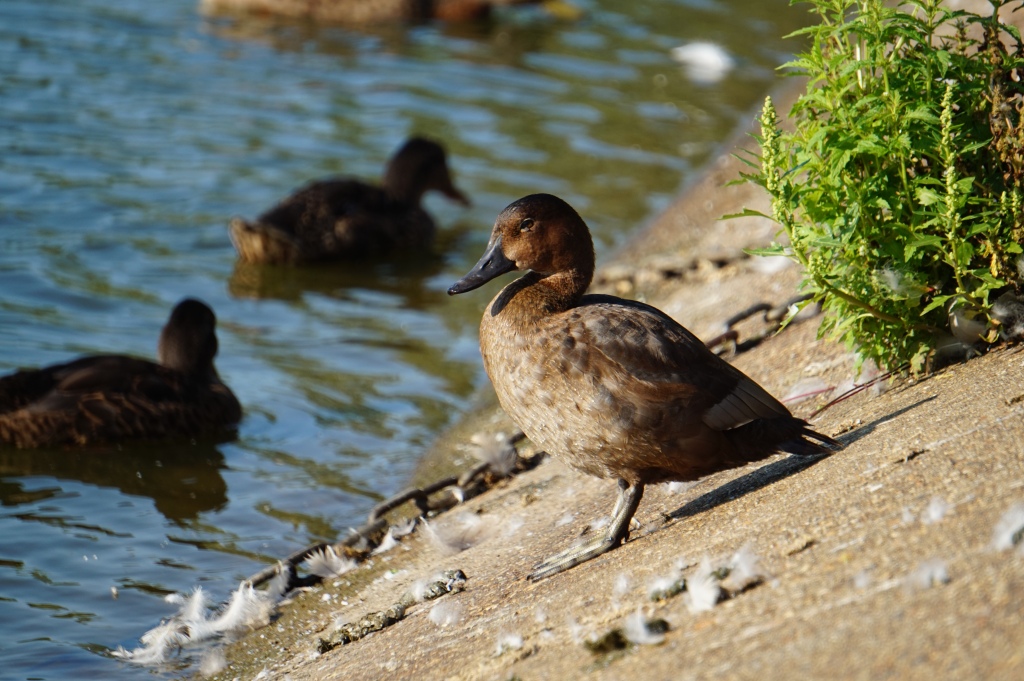
Juvenile Fairlands Lakes 24 August 2021.
Frequent visitor in small numbers.
Frequent visitors to Fairlands Valley Lakes, with records from every month of the year. They were first recorded on 21 December 1972 when three were seen. The most seen together are 12 on 7 May 2025. A long staying pair were seen there in May and June 2009, and again briefly in July, but made no attempts to nest.
The earliest record for Stevenage comes from a photograph in Stevenage Museum (PP2176), showing nine Tufted Ducks on the newly completed Town Centre Gardens Pond dated c. 1960.
A single drake was seen on several occasions at the Town Centre Gardens in 1981.
Very rare visitor.
Four records from Fairlands Valley Lakes: a female from 23 April until 2 May 1979 when it was found dead, and was given to Stevenage Museum. (This was only the second record of this species in North Hertfordshire, the first was from Radwell Mill in 1913), a male and female on 18 March 1980, a drake on 2 April 1981, and a female on 21 April 1990.
Rare winter visitor and passage migrant
Rare visitors to Fairlands Valley Lakes, the first record was a female seen from 1 to 11 February 1982. There was one further record from the 1980s, one seen on 27 December 1982.
Three records from the 1990s: a drake on 16 March 1991; a female on 9 April 1997; two females on 19 November 1997.
Between 2000 and 2009 three records: a female on 2 November 2001; a female on 30 October 2006 (possibly the same bird recorded by the WeBS in November); a drake on 23 January 2007.
Seven records between 2010 and 2019: a drake on 31 December 2011; two females on 3 November 2016; drake and female on 15 December 2016; a drake on 5 January 2017; a drake on 8 November 2017; a female on 14 November 2017; a drake on 24 November 2018.
The records since 2020: a female on 23 and 30 October 2021; two females on 23 November 2021; a female on 20 December 2021; a female on 6 February 2023; a female on 9 December 2024; a drake on 15 November 2025.
Three were also seen at the Town Centre in April 1989.
Very rare visitor
Ten records from Fairlands Valley Lakes: two on 24 November 2007; one on 31 January 2009; a drake from 3 to 12 March 2010; three in flight over the Environmental Lake on 9 February 2012; a drake on 4 December 2021; a drake on 27 December 2021; a drake seen flying over on 7 January 2024; one seen flying over on 20 November 2024; two drakes and a female on 8 December 2024; one flying over Fairlands Farmhouse on 23 November 2025.
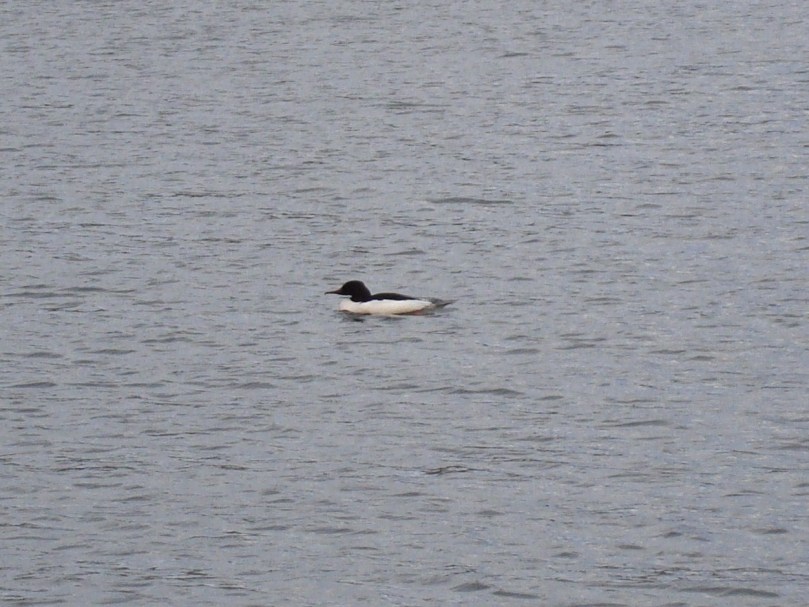
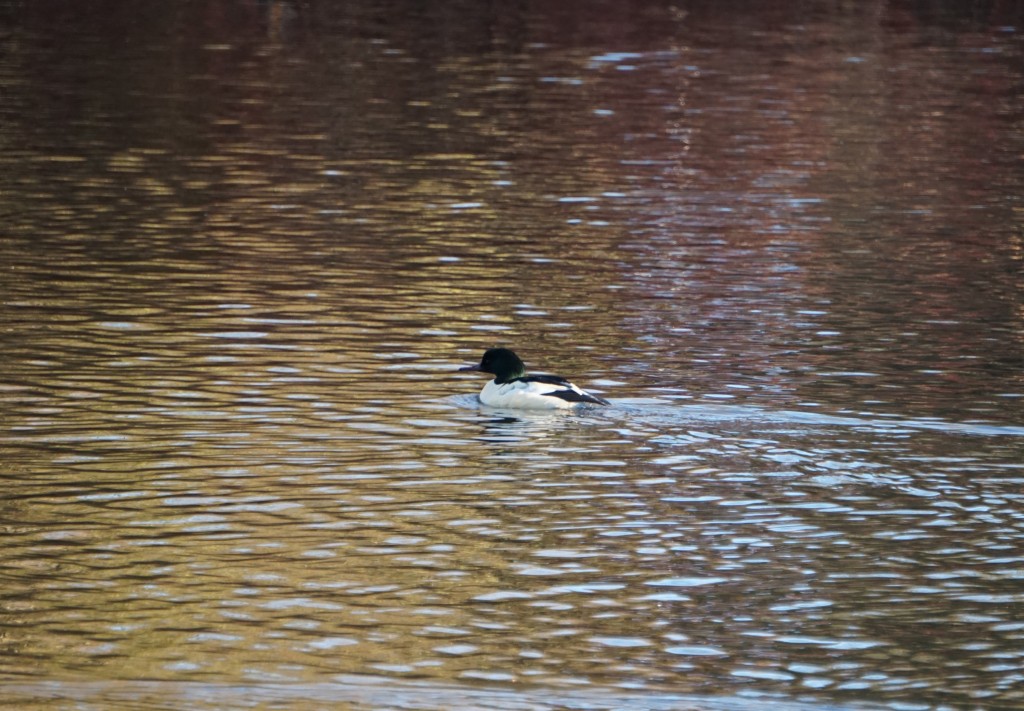
Very rare visitor.
Ruddy Ducks are native birds of North America that colonised southern and central England following the escape of captive birds from the Wildfowl and Wetlands Trust Centre at Slimbridge during the 1950’s. Their spread has been considered to be a conservation disaster as they are believed to have spread as far as Spain and hybridised with the endangered White – headed Duck (Oxyura leucocephali). In 2000 the UK Government initiated a programme of shooting to try and eliminate the species.
Three records from Fairlands Valley Lakes: One on 23 April 1983 (this was the first record for North Hertfordshire), a female on 17 July 2000 and, a drake and duck on 29 July 2000.